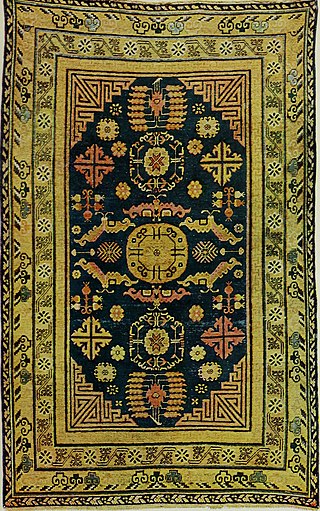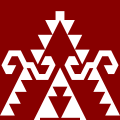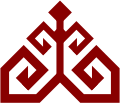
A carpet is a textile floor covering typically consisting of an upper layer of pile attached to a backing. The pile was traditionally made from wool, but since the 20th century synthetic fibers such as polypropylene, nylon, or polyester have often been used, as these fibers are less expensive than wool. The pile usually consists of twisted tufts that are typically heat-treated to maintain their structure. The term carpet is often used in a similar context to the term rug, but rugs are typically considered to be smaller than a room and not attached to the floor.

A Persian carpet or Persian rug, also known as Iranian carpet, is a heavy textile made for a wide variety of utilitarian and symbolic purposes and produced in Iran, for home use, local sale, and export. Carpet weaving is an essential part of Persian culture and Iranian art. Within the group of Oriental rugs produced by the countries of the "rug belt", the Persian carpet stands out by the variety and elaborateness of its manifold designs.

A kilim is a flat tapestry-woven carpet or rug traditionally produced in countries of the former Persian Empire, including Iran, the Balkans and the Turkic countries. Kilims can be purely decorative or can function as prayer rugs. Modern kilims are popular floor coverings in Western households.

A prayer rug or prayer mat is a piece of fabric, sometimes a pile carpet, used by Muslims, some Christians and some Baha'i during prayer.

Anıtkabir is a complex located in the Çankaya district of Ankara, which includes the mausoleum of Mustafa Kemal Atatürk. Designed by Emin Onat and Orhan Arda, the construction of Anıtkabir began in 1944 and was completed in 1953. In addition to the mausoleum building, the complex consists of various structures and monuments, as well as a wooded area known as the Peace Park.
An oriental rug is a heavy textile made for a wide variety of utilitarian and symbolic purposes and produced in "Oriental countries" for home use, local sale, and export.

In art and iconography, a motif is an element of an image. The term can be used both of figurative and narrative art, and ornament and geometrical art. A motif may be repeated in a pattern or design, often many times, or may just occur once in a work.

Bergama Carpet refers to handwoven Turkish carpets, made in the Bergama district in the Izmir Province of northwest Turkey. As a market place for the surrounding villages, the name of Bergama is used as a trade name to define the provenience.

Anatolian rug is a term of convenience, commonly used today to denote rugs and carpets woven in Anatolia and its adjacent regions. Geographically, its area of production can be compared to the territories which were historically dominated by the Ottoman Empire. It denotes a knotted, pile-woven floor or wall covering which is produced for home use, local sale, and export. Together with the flat-woven kilim, Anatolian rugs represent an essential part of the regional culture, which is officially understood as the Culture of Turkey today, and derives from the ethnic, religious and cultural pluralism of one of the most ancient centres of human civilisation.
Iranian handicrafts are handicraft or handmade crafted works originating from Iran.

Ardabil rugs originate from Ardabil located in the province of Ardabil Province in northwestern Iran, 639 kilometers from Tehran. Ardabil has a long and illustrious history of Persian carpet weaving.

Islamic geometric patterns are one of the major forms of Islamic ornament, which tends to avoid using figurative images, as it is forbidden to create a representation of an important Islamic figure according to many holy scriptures.

Bessarabian rugs and carpets are the commonly given name for rugs in pile and tapestry technique originating in Russian provinces as well as Ukraine and Moldova during the late 19th and early 20th centuries.1 Some scholars will classify flat-woven carpets as Bessarabian, while referring to knotted-pile carpets as Ukrainian.2 They are predominantly from an area corresponding to modern Bulgaria and Romania.3 Produced under late Ottoman rule, they stand right on the cusp of European and Oriental carpet weaving.

A gul is a medallion-like design element typical of traditional hand-woven carpets from Central and West Asia. In Turkmen weavings they are often repeated to form the pattern in the main field.
Adana Ethnography Museum, exhibits the ethnographic works, the inscriptions of Adana's landmarks and epitaph and gravestones of Adana's leading figures. The museum was opened in 1983 at the former Greek Church after Archeological Museum moved to its new location. As of May 2012, the museum was closed as it would move to the newly built Museum Complex in 2016. In April 2019 it had not yet been realised.

Soumak is a tapestry technique of weaving sturdy, decorative fabrics used for carpets, rugs, domestic bags and bedding, with soumak fabrics used for bedding known as soumak mafrash.
Pirot rug, Pirot carpet or Pirot ćilim refers to a variety of flat tapestry- woven rugs traditionally produced in Pirot, a town in southeastern Serbia. The Pirot kilim is often referred as one of the National symbols of Serbia and in the same time is regarded as an important part of Bulgarian folk heritage, because Pirot was historically also populated by Bulgarians. While Pirot is the historic center for the production of this carpet style, the Pirot rug is part of a broader history of Balkan rug making, with Pirot style carpets traditionally found across the region, from modern-day Bosnia to Turkey. The Turkish name for the town of Pirot, Şarköy, has also given the name "sarkoy" or "sharkoy" to carpets of the same style produced in modern-day Turkey, while the adjacent town of Chiprovtsi across the border in Bulgaria has become recognized as another important center for this same carpet tradition.
Scandinavia has a long and proud tradition of rug-making on par with many of the regions of the world that are perhaps more immediately associated with the craft—regions such as China and Persia. Rugs have been handmade by craftspeople in the Scandinavian countries of Denmark, Finland, Norway, and Sweden for centuries, and have often played important cultural roles in each of these countries. Contemporary Scandinavian rugs—most especially Swedish rugs—are among the most sought after rugs in the world today, largely due to the contributions of designers like Marta Maas-Fjetterstrom. The story of Scandinavian rugs is a vital chapter in the cultural study of Scandinavia, as it reveals a great deal about the aesthetic and social conventions of that region.

Many motifs are used in traditional kilims, handmade flat-woven rugs, each with many variations. In Turkish Anatolia in particular, village women wove themes significant for their lives into their rugs, whether before marriage or during married life. Some motifs represent desires, such as for happiness and children; others, for protection against threats such as wolves and scorpions, or against the evil eye. These motifs were often combined when woven into patterns on kilims. With the fading of tribal and village cultures in the 20th century, the meanings of kilim patterns have also faded.

Jajim also spelled as gelims, or Jajim-bafi, is a handmade, flat-woven textile made of colored natural fiber which is created and used in the majority of villages and rural areas of Iran. Other locations the Jajim is found include Azerbaijan, Turkey, and India.



















